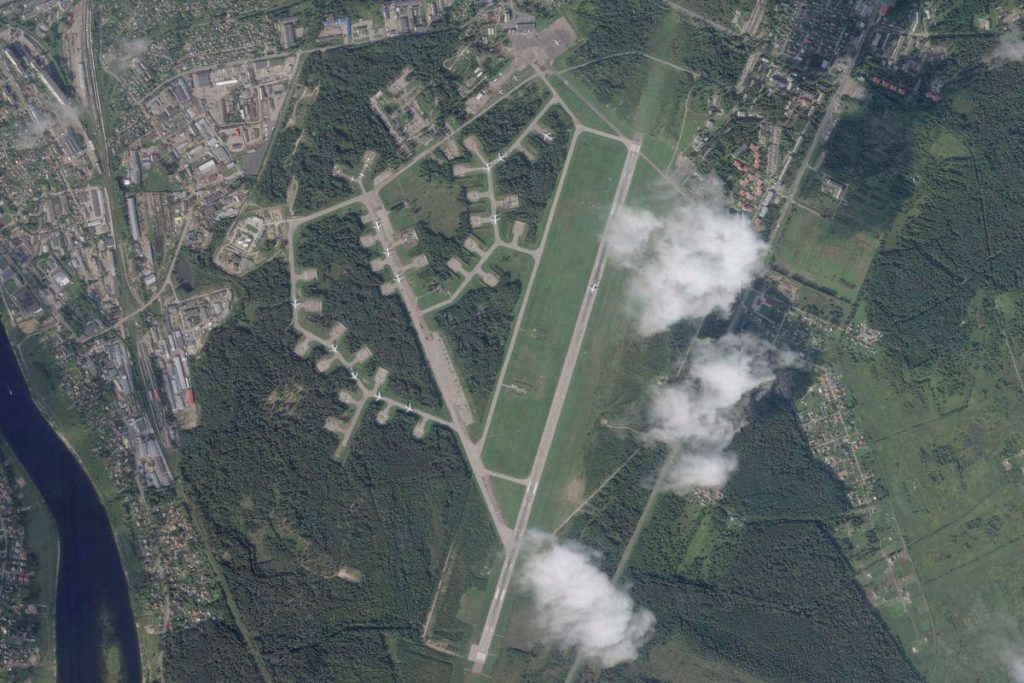As the war in Ukraine is now in its 18th month, Ukrainian forces have begun to make progress with its long-anticipated counteroffensive—but Kyiv has also been stepping up its drone strikes within Russia. Just this week, Ukraine launched multiple strikes and that included a drone attack on the Pskov airbase near the Estonian border, in which two Il-76 transport aircraft were destroyed and two others seriously damaged.
Moscow had attempted to downplay the recent attack, but on Friday, a video circulated on social media that corroborated Kyiv’s claims, which showed the destruction of the aircraft.
Though both sides have employed social media to share the destruction of the other side’s tanks and other armored platforms on the ground, this recent video goes beyond the normal “war porn” clips—and could be considered another propaganda victory for Kyiv as it directly contradicts Russian claims.
“I place zero faith in statements from Moscow. It’s reasonable to treat Ukrainian releases skeptically, but they don’t need to try to fake videos. They’re doing well enough, and the consequences for getting caught are serious. Ukrainian credibility would suffer with backers to the West,” explained James Hasik, senior fellow for defense technology at the Center for European Policy Analysis (CEPA).
Covering The Conflict In Near Real Time
The convergence of drones, which can literally be an eye in the sky, with social media has now allowed the conflict in Ukraine to be broadcast to the world in near real-time. It thus makes it that much harder for either side to make false claims, as the Kremlin attempted to do this week in the drone strike on Pskov.
“In this case, there’s plenty of evidence that this all really happened,” added Hasik. “You have probably separately seen the satellite photography that indicates that at least two of those transport aircraft are total losses. We can definitely say that at least a few of those Ilyushins will not be flying again.”
Social media has also changed the way such events are reported—noted by the tweets from Federico Borsari, another fellow at CEPA for transatlantic defense and security, that offered commentary on the drone strike.
In one post, Borsari explained, “The attack was conducted using long-range one-way attack (OWA) UAS (aka kamikaze drones) deployed in large numbers to saturate & overwhelm traditional air defenses. These systems typically have a propeller engine, GNSS+inertial navigation system guidance & a medium-sized warhead,” while he further noted, “Ukraine began to experiment with OWA drones one year ago.”
Giving Away Too Much
One concern with the videos is that soldiers on the ground could be revealing their movements and even their locations through their social media posts. In this recent drone strike, a question could be asked whether it exposed any sensitive information.
“You have probably heard that Major General Kyrylo Budanov, head of Ukrainian military intelligence, said today that the attack was carried out from within Russia,” noted Hasik. “The Ukrainians have been using those for over a year, every day, so they clearly know how to do that. Drones like that are easy enough to hide in the back of a truck, so it’s not shocking that the Ukrainian special services could pull this off. They have repeatedly demonstrated their prowess.”
Hasik also said he didn’t see any serious downside in releasing such videos from the front lines.
“Satellite imagery has made hiding things in warfare very difficult. The victors might as well advertise their successes, because someone with an overhead sensor was going to notice quickly anyway,” Hasik continued.
“Overall, this is another example of operational success by Ukraine–in this case the intelligence/security services rather than the conventional armed forces in the field–but also of Ukraine’s continued success in the competition in the global information domain,” added Steven L. Horrell, nonresident senior fellow for transatlantic defense and security at CEPA.
Ukraine could also win the propaganda war via such videos.
“While Russia’s missile and drone strikes continue to target population centers and civilian infrastructure within Ukraine, Ukraine’s attacks within Russia have overwhelmingly been against military and logistics targets,” said Horrell. “The released video demonstrates some pinpoint precision in striking aircraft rather than apartment buildings.”
Social Media Won’t Replace Fact-Checkers
Even as Ukraine used the footage as evidence that the transport aircraft suffered far more significant damage than Russia acknowledged, it should be noted that video can still be manipulated. The technology can just as easily spread misinformation and disinformation.
Video can also be employed out of context—and that has already happened quite a bit in the conflict in Ukraine.
“In this case, opposing actors have always framed narratives supported by images that support their position,” warned Dr. Cliff Lampe, professor of information and associate dean for academic affairs in the School of Information at the University of Michigan.
“This is why the U.S. is always so careful about when the remains of soldiers arrive back to the country and how the media presents them,” added Lampe. “What social media has changed here is the ability to work around traditional media, which can have gatekeepers that include governments, or oligarchs with agendas of their own. By posting content directly to social media, they are able to present an alternative narrative without having to go through these gatekeepers. We’ve seen this basic pattern in political campaigns, broad-reaching protests, and now in shaping war narratives.”
Read the full article here










